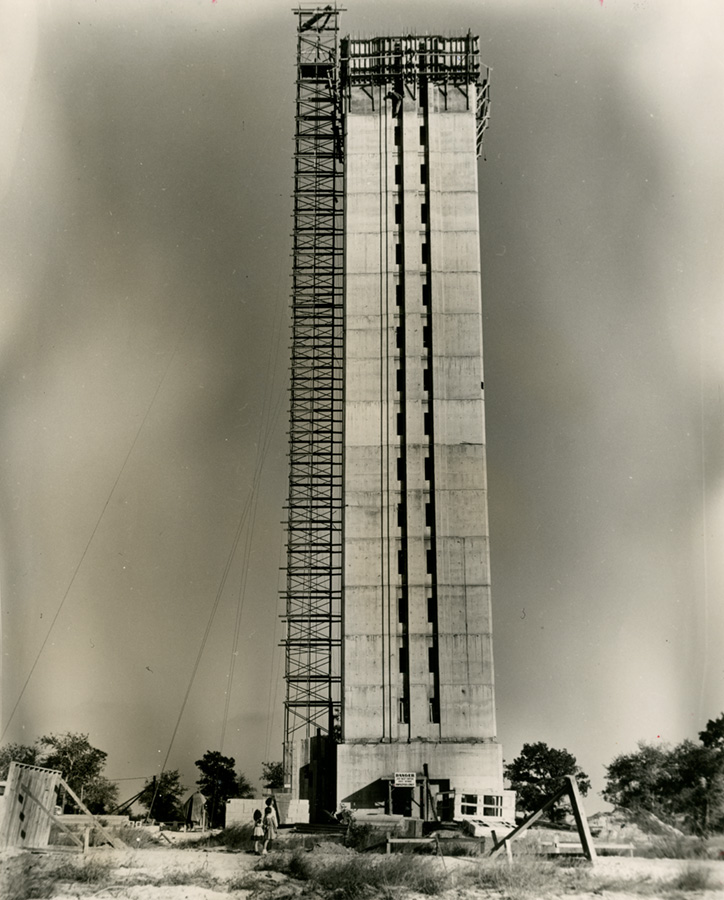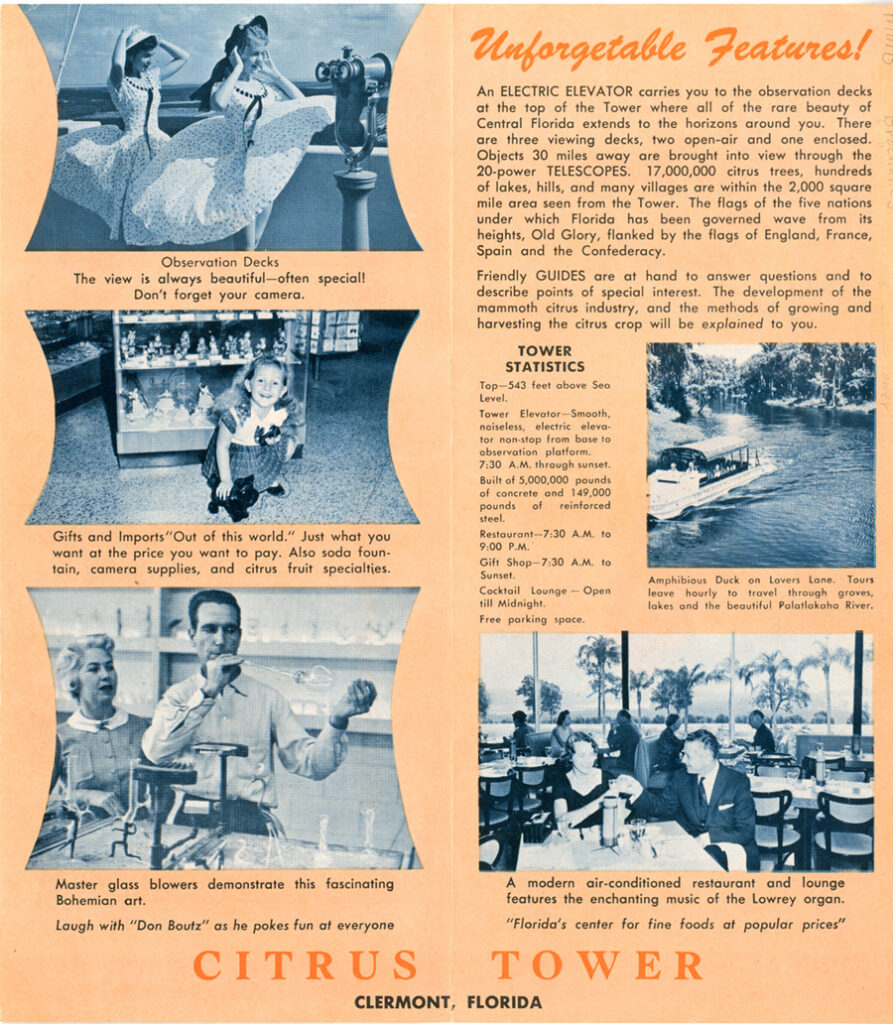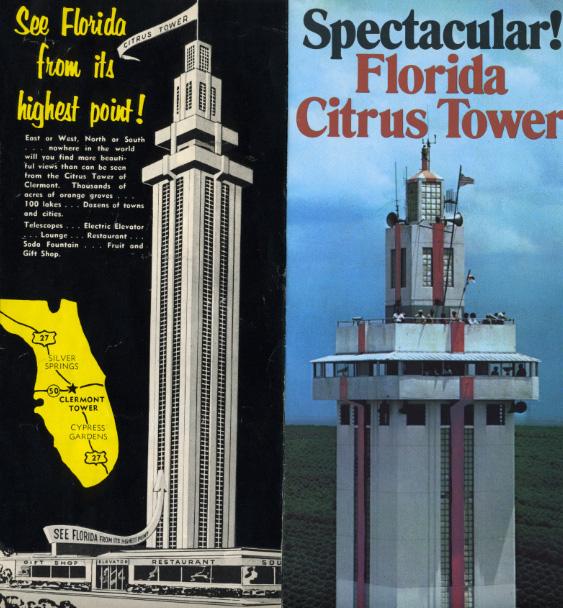An Orange-Colored History of One of Florida’s Oldest and Tallest Attractions
By Clay Waters from the Fall 2023 edition of Reflections Magazine
For more than 60 years, the Citrus Tower in Clermont has stood sentinel over a deep slice of Central Florida. Featuring a 360-degree observation deck that provides a view of eight counties, the orange-and-white edifice, situated 23 miles west of Orlando, was built to hail the area’s citrus industry. That industry is no longer viable in Lake County, but the Citrus Tower still retains its appeal as one of the state’s longest-standing, and tallest-standing, tourist attractions, harkening back to when Florida’s population was a mere four million (in 2023, it stands at more than 22 million). Throughout its orange-hued history, the Citrus Tower has hosted glassblowers, a citrus-packing plant, alligators, candymakers, pythons, a future governor, and even a vice president.
After years of imagining and planning, construction begin in July 1955 on a high elevation point – high for Florida, in any case – right off of U.S. Highway 27. Today that stretch of U.S. 27 has six lanes, but at the time it was only a two-lane highway, one lane running north and one south. The Citrus Tower’s grand-opening ceremony a year later, on July 14, 1956, was attended by C. Farris Bryant, then a Democratic primary candidate who would be elected Florida’s governor in 1960. Gov. LeRoy Collins was invited but sent a telegram instead.
In a diplomatic mission of sorts, the grand opening also drew representatives from Cypress Gardens in Winter Haven, to the south, and Silver Springs near Ocala, to the north. The Citrus Tower was situated roughly at the midpoint between those titans of Florida tourism. Water from Silver Springs christened the new attraction, while Cypress Gardens sent some of its famed Southern Belles.
In the mid-1950s, Central Florida tourism was a hodgepodge. Besides Cypress Gardens and Silver Springs, Bok Tower Gardens had opened in Lake Wales in 1929, and Weeki Wachee’s underwater mermaid show opened in 1947, followed by Gatorland in 1949. In northeast Florida, the “Fountain of Youth” legend had been drawing tourists to St. Augustine and its supposedly magic waters for almost a century.

The Citrus Tower in Clermont under construction in late 1955 or early 1956. The attraction on U.S. Highway 27 opened on July 14, 1956.
Origins in the 1940s
The story of the Citrus Tower begins in the 1940s. The concept was the brainchild of Clermont mayor and automobile dealer Ralph Harper, who had long tried to convince locals of the need for an observation tower to showcase Central Florida’s citrus industry. The pleas fell on deaf ears until entrepreneur Alfred William Thacker came to town.
Thacker, owner of the Tilley Lamp Co. of Pittsburgh, Pennsylvania, vacationed in Clermont in 1952 and evidently saw potential there. He moved down and built the Skyline Motel on the north side of U.S. 27. He also owned an adjacent piece of elevated land that would become the proposed site of the tower.
Intrigued by Harper’s idea, Thacker called on some friends from Pittsburgh, including Frederick Jack Toole, founder of the Triangle School of Drafting, who would end up designing the tower. (In the 1960s Toole founded the Presidential Hall of Fame, adjacent to the Citrus Tower, which is still in operation today.)
The architect on the project was Thomas Russell, also of Pittsburgh. Thacker would cart around a scale model of the proposed tower to local civic groups to drum up interest. The Florida Towers Corp. was formed, stock was sold, and construction began in July 1955.
The original plans envisioned a 60-foot height, but the tower kept growing in the shareholders’ imaginations. Its final actual height of 226 feet made it the highest observation deck in Florida, stretching to 543 feet above sea level at the top. It remains the highest observation deck in the state, according to Florida Traveler.
From the lobby, visitors could ride via elevator to the open-air observation deck with its waist-high concrete barrier and, on a clear day, take in a comprehensive view for 35 miles all around, a circle of Central Florida encompassing parts of eight different counties and showcasing vast rows of citrus groves. An estimated 17 million citrus trees, one-third of Florida’s annual citrus industry, were once visible from the top of the Citrus Tower. The building itself was also striking, with bold colors that encapsulated the bright, creamy quality of an ice-cream treat.
Citrus queens were crowned at the Citrus Tower, charming newspapers as far away as Wilmington, Delaware. In the late 1950s, amphibious “duck tours” (actually repurposed World War II craft) took tourists to, and into, Lake Minneola. At the base, visitors could stop by the gift shop, dine at a restaurant, and witness a model orange-packing plant in action.
The attraction even hosted alligators for a time during the 1960s. Jack Raymon’s Wildlife Arena opened at the Citrus Tower in January 1960. A history of Clermont by local author Doris Bloodsworth features a 1961 photo of Raymon, a herpetologist, with “ ‘Old Hurricane,’ believed to be the largest alligator in captivity.” Thacker’s animal-loving son William took over the renamed Citrus Tower Wildlife Arena in May 1963 and imported animals from his own private zoo.

Promotional brochures from its heyday show its setting among a rolling vista of orange trees, reaching as far as the eye could see, and advertised features including a glass-blowing demonstration, soda fountain, and gift shop.
Competition arrives
The Citrus Tower initially performed as hoped, attracting some 500,000 visitors a year in the 1960s. But its cultural cachet began slipping after the Florida Turnpike burrowed into Lake County and began routing people off Highway 27. Competition from Walt Disney World began to siphon off crowds in 1971.
A Miami-based conglomerate, Wometco, bought the property from the Florida Towers Corp. in 1972. (The unwieldy handle “Wometco” hails from the age of truncated corporate names; it was an abbreviation for the Wolfson-Meyer Theater Company, a movie theater chain based in Miami.) A poster from the era featured in the lobby of the Citrus Tower reveals just where the tourist crowds were moving: “Spectacular! Florida Citrus Tower 17 miles from Disney World on U.S. 27 in Clermont.”
Wometco tried to spur tourist interest, adding Carolyn’s Candies and a glass-blowing studio hosted by the Boutz family of artists, led by Don Boutz. But by 1984 Wometco was looking to sell. The citrus groves were disappearing, cut down by greening disease and successive freezes in the 1980s, which made citrus farming unviable in Lake County. The view was “certainly not what it used to be,” the general manager at the time, Ed Rainey, told the Orlando Sentinel.
The attraction’s appeal had reached its nadir by the mid-1980s. Visitor figures dipped to around 50,000 annually. A dystopian Orlando Sentinel article by Jeff Kunerth, dated December 10, 1985, began: “A mausoleum-like solitude descends upon the Citrus Tower at sunset. . . .
Gone are the people. Gone are the trees.” The structure was saved from closing when it was bought by another group of Miami investors in 1986, led by Mike Samole.
In 1988, the new owners added a tram tour to take visitors through an orange grove, where they could learn about the history of citrus in Lake County. Vice President Dan Quayle stopped by for a campaign rally in August 1992, during the unsuccessful Bush-Quayle re-election campaign.
In 1995, new owner Greg Homan changed the original orange stripe to two turquoise stripes, as a tribute to Lake County’s namesake lakes. (The orange-and-white pattern was restored in 2015.) Two years later, Jeff Klinkenberg of the St. Petersburg Times wrote affectionately in a Feb. 16, 1997, article that the Citrus Tower was one of Florida’s “strangest tourist attractions.”
Greg Homan’s son Scott and Scott’s wife Heather took over in January 2019 and installed a coffee shop in the cheerful lobby, which retains the structure’s original terrazzo tiles. Two glass display cases showed off old souvenirs and artifacts, including a Fisher Price View-Master disc dedicated to the attraction. The original carillon bells that used to chime at noon were displayed in the lobby, which also contained an updated scale model of the structure.
The view of citrus trees at the tower has been replaced in part by a present-day Florida landmark, a Publix grocery store that anchors a nearby shopping center. Community development is visible from every angle, along with several lovely lakes and even a few citrus trees. A YouTube comment on an archived video showing the view from the observation deck neatly, if opinionatedly, encapsulated the shifting status of the surrounding area: “The 1956 view shows nothing but citrus trees. The 1994 view shows nothing but open fields. Now, the 2007 view is nothing but houses. I miss the old days!”
Anyone who wishes to judge the view for themselves can ride to the top of the Citrus Tower, in a modernized elevator that retains its traditional “old-school” look, for a self-guided tour any day of the week. Signs posted around the observation deck, now enclosed with glass, point out the direction of various sights, including Sugarloaf Mountain, the downtown Orlando skyline – and, of course, Walt Disney World.
Note: In February 2023, the Homan family announced the sale of the Citrus Tower in September 2022 to a Colorado-based religious group, Simchat Torah Beit Midrash, led by Rabbi Ralph Messer and Maureen Messer. After renovations, the tower reopened to visitors in May 2023. For more information, visit CitrusTower.com.


